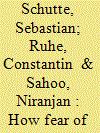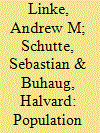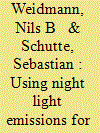|
|
|
Sort Order |
|
|
|
Items / Page
|
|
|
|
|
|
|
| Srl | Item |
| 1 |
ID:
141192


|
|
|
|
|
| Summary/Abstract |
This study introduces a theoretical model of how insurgency develops as a function of reactive mobilization. The theory extends a classic distance-decay model by incorporating Kalyvas’ typology of violence. It implies that geographic conditions crucially determine the accuracy of applied violence and thereby its public perception, which in turn determines the actors’ ability to mobilize. As a first test of these effects, I propose a new geographic indicator that expresses the spatial accessibility of a country’s population for both central governments and peripheral insurgent movements. Two empirical implications of the theory are tested with a large-N data set on outcomes and casualties in insurgencies. The new indicator is significantly associated with both military outcomes and the number of casualties in insurgencies since 1970 and strengthens statistical predictions.
|
|
|
|
|
|
|
|
|
|
|
|
|
|
|
|
| 2 |
ID:
190934


|
|
|
|
|
| Summary/Abstract |
Earlier research on ethnic and religious conflict has identified fear as an important motivation. While theoretically sound, this expectation has never been tested at larger scales in ongoing episodes of political violence. Instead, conceptual progress has been made in lab experiments. Combining insights from observational research and stylized experiments, we predict that fear for personal safety due to witnessed violence causes prejudice against out-groups, enhanced internal cohesion, and support for extremist actors. To test these predictions, we conducted surveys in the Indian State of Uttar Pradesh with identical respondents in three waves starting in January 2017. The surveys continued during the tense Legislative Assembly elections in the Spring. The results largely corroborate the theoretical expectations and present a hard in-vivo test of long-standing conjectures.
|
|
|
|
|
|
|
|
|
|
|
|
|
|
|
|
| 3 |
ID:
137786


|
|
|
|
|
| Summary/Abstract |
One of the most powerful predictors of violent political conflict is proximate violence in space and time. This spatiotemporal pattern has been identified between countries as well as within them. What explains this clustering is less clear, and different studies point to different mechanisms. Focusing on sub-Saharan African states, we examine whether population attitudes may contribute to the spread of political violence at subnational scales. In a quasi-experimental research design—using georeferenced survey data of 18,508 respondents for 162 administrative units across 16 countries, paired with precisely georeferenced conflict event data—we find that popular acceptance of (the legitimacy of) the use of physical violence is positively associated with subsequent conflict events. Furthermore, the combined effect of nearby violence and approval of violence is stronger than either condition alone, implying a diffusion effect. While we find some evidence that conflict events affect later public opinion, our final models control for violence that occurred before the survey data were gathered. The fact that we include such violence in our analysis suggests that the reported results cannot be dismissed as merely reflecting a reverse causal relationship.
|
|
|
|
|
|
|
|
|
|
|
|
|
|
|
|
| 4 |
ID:
152294


|
|
|
|
|
| Summary/Abstract |
Nighttime illumination can serve as a proxy for economic variables in particular in developing countries, where data are often not available or of poor quality. Existing research has demonstrated this for coarse levels of analytical resolution, such as countries, administrative units or large grid cells. In this article, we conduct the first fine-grained analysis of night lights and wealth in developing countries. The use of large-scale, geo-referenced data from the Demographic and Health Surveys allows us to cover 39 less developed, mostly non-democratic countries with a total sample of more than 34,000 observations at the level of villages or neighborhoods. We show that light emissions are highly accurate predictors of economic wealth estimates even with simple statistical models, both when predicting new locations in a known country and when generating predictions for previously unobserved countries.
|
|
|
|
|
|
|
|
|
|
|
|
|
|
|
|
| 5 |
ID:
155184


|
|
|
|
|
| Summary/Abstract |
Insurgency and counterinsurgency are widely described as “population-centric warfare”: a competition between military actors over civilian loyalties. Drawing on a high-resolution conflict event data set and a new approach for analyzing reactive behavior in space and time, this article answers the question of how civilian cooperation and defection are systematically driven by incumbent and insurgent violence. Theoretically, the study contributes to resolving a dispute between proponents of deterrence- and alienation-based approaches to population-centric warfare. Empirically, this analysis improves upon the mixed results from previous microstudies in favor of an integrated picture: indiscriminate violence has almost no effect on collaboration with the adversary in its immediate spatiotemporal vicinity. At larger levels of aggregation, however, a clear reactive pattern of collaboration with the adversary becomes visible which is in line with alienation-based reasoning.
|
|
|
|
|
|
|
|
|
|
|
|
|
|
|
|
|
|
|
|
|